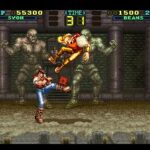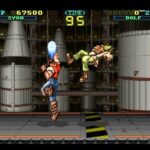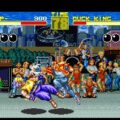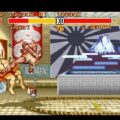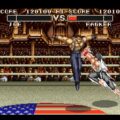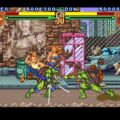Developer: Jaleco Publisher: Jaleco Released: 1993 Genre: Fighting
Once Street Fighter 2 changed the landscape for fighting games the deluge of follow-up titles was inevitable. That being said I am honestly shocked at just how fast the game industry hopped on the bandwagon. Publishers who you would never associate with the genre threw their hat in the ring with some titles being good but many being awful. Jaleco’s Tuff E Nuff is a surprisingly solid entry in the genre from an unlikely source and while it is not entirely original it nails the fundamentals.
I like Tuff E Nuff but let’s be honest, one of the main reasons anyone remembers it is because of its awful box art. Tuff E Nuff comes from the Phalanx school of “what in god’s name were they thinking?” I get the thought behind it: someone directly addressing the customer will get their attention and at the least look at the back of the box. But I think it did more harm than good. Those that took the plunge found a game with good production values and a few interesting ideas.
The game’s story is another take on Fist of the North Star. In a post-apocalyptic Earth a man named Jade has found a suit of blue armor that gives him the power to take over the world. He erects a massive tower and employs six guards to protect him from those that would try take his empire. Jade stages a tournament to see who is the strongest, with the four remaining states outside of Jade’s domain sending their champion to compete. Now they must fight amongst themselves to see who will try to take Jade out.
Tuff E Nuff has three modes: Story, 1 player vs CPU and your standard multiplayer mode. Story and player vs CPU are basically identical outside of the story mode featuring a battle against the final boss. This is because all of the dialogue between characters in story mode has been removed. Even the ending has been cut which is a blow to Story mode. This is just one of many quirks in the game but luckily it has a solid foundation to carry it.
The game uses a four button setup like King of Fighters, with weak and strong punches and kicks. You can only choose among the four heroes in most modes without a cheat code. Tuff E Nuff was not the first game with this limitation (that would be Fatal Fury) but it is pretty stupid. The main quartet consists of Syoh, Kotono, Zazi, and strongman Vortz. Your options are narrower than they appear as Syoh and Zazi are the requisite clones every fighting game must have. That familiarity extends to the special moves. Most button commands are simple next to Capcom’s title but a few are weird. You execute charge moves by holding forward rather than back. Those are outliers however as the tight controls allow you to execute most moves nine times out of ten.
The fighting engine in Tuff E Nuff is very basic. There are no combos which makes it feel limiting. The CPU AI is predictable at first but spikes toward the top of the tower. This imbalance carries over to the multiplayer mode if you use a cheat code to play as all the bosses. It is apparent most of the work went in to the main quartet as they feel complete. The bosses are fun to play around with once or twice but are terribly unbalanced. Sadly this does kill the longevity of the game as multiplayer is where most fighting games live or die.
Tuff E Nuff has a few features that were not standard at the time of its release. In the Story mode your special moves become more powerful after every two battles. The difference is notable and welcome as the later CPU opponents are tough. Also the story mode gives passwords after every match to track your progress. There are ten matches up the tower which is a lot but not so much that the game needs passwords. I appreciate the gesture though. The coolest is a replay mode which lets you slow down and highlight the last moments of a round. Even now most games don’t offer this feature and it is really cool to play around with.
In Closing
Tuff E Nuff is pretty good for an original SNES fighting game. It has great graphics, tight control, and a solid mechanics. The only thing holding it back is the small roster of characters without a cheat code and the excision of its story. Tuff E Nuff is not a game that I would rush out and buy. But I would spend an afternoon with it if it were available.


